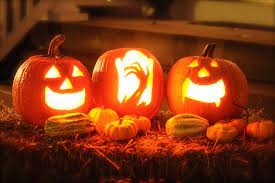The origins of Halloween go back to the times of the ancient Celtic festival of Samhain. This tradition begins on Oct. 31 and goes until Nov. 1 when it welcomes the end of summer and introduces the “Dark Half of the Year.”
Those who celebrate believe that during Samhain, the wall between the physical and spiritual world comes down which allows interaction between what they call the “otherworld” and ours. This time is typically associated with human death as we welcome the cold and dark winter.
The Celts believed that the time of interaction between both worlds presented a unique opportunity for priests to make predictions about the future. In these times, limited access to information meant celebrants were highly dependent on their natural environment and sources around them. They held the priest’s predictions close to and true to help comfort them in the cold winter.
Along with the Celtic priests came Druids (members of the high-ranking priestly class in ancient Celtic cultures). Throughout these times they would build fires while citizens would gather to make sacrifices and burn items. During this, the Celts would wear costumes and partake in fortune-telling. Finally, when the celebration was over, they would take what had burned and re-light them to help protect against the long and dark winter to come.
In centuries to come, Christianity soon tried to reinvent the Samhain tradition by turning it into a Christian celebration. In the fifth century, the leaders of the Christian church tried moving the celebration to May 13. This however did not stop the festivities still held in the months of October and November Finally, it wasn’t until the 9th century that a Pope declared that All Saints Day would be Nov. 1 which led All Souls’ Day to be celebrated on Nov. 2.
During their celebrations, they dressed up as angels, devils and saints while having parades and bonfires. All Saints’ Day was also called All-Hallows which later turned into All-Hallows Eve and settled on Halloween.
Halloween wasn’t taken too kindly in some places quite yet. Places such as Colonial New England had their beliefs that were very contained. However, in more southern colonies and states, Halloween was common and sought after. Since there were many immigrants coming from other countries, different beliefs mixed with each other helped blossom what we know today.
From telling stories to dressing up, many of these traditions are from centuries ago or even recently created. The biggest starter of Halloween is immigrants coming from Ireland due to the potato famine, which led to popularization nationally in the country.
What we know from today’s traditions are trick or treating, bobbing for apples, decorating houses and many other fun traditions.
Dr. Bruce tells The Carroll News “Kids going out for trick or treating and asking for candy and playing tricks. That’s really a 20th-century phenomenon, but you can still see that it has these links to this past and some of these past traditions that we have turned what originally was a spiritual and seasonal event into something that’s purely fun.”
But how has it changed from the past? Back then, the poor would go and visit the wealthier families and exchange soul cake pastries for a prayer to the rich’s dead family. This practice is known as “souling” which later was picked up by children who would go from house to house and ask for gifts and food. In other regions, children would do something similar known as guiding. This is when they would dress up in costumes but instead of praying for the dead, they would sing, tell jokes, or do some kind of trick to receive their treats which could be food or money.
Other traditions such as carving pumpkins have plenty of stories on how they came about. Some say that the story of Stringy Jack playing tricks on his neighbors was a big part; while others say that it comes from the worry that souls who wandered the blurred lines of the veil would come into their houses. As a way to ward them off, people would carve faces into turnips and pumpkins in the hope that they would steer the spirits away.
Bruce said that another form of this was “the tradition of lighting the candles in gourds.” Nowadays pumpkin carving is a way to decorate and still ward off those unwanted spirits, also making for a great snack.
In modern times, Halloween has evolved into a vibrant and diverse celebration that stays in touch with its ancient traditions and heritage. While the Celtic tradition of Samhain started off Halloween, the holiday has since grown and become a great recognized occasion for family, friends and neighbors to enjoy every year.
People from all walks of life come together to express their creativity and indulge in a shared sense of fun and wonder. With traditions such as trick or treating, pumpkin carving and decorating there are many things to enjoy. As this celebration continues, it’s essential to remember the fascinating history and the rich beliefs that have contributed to making Halloween the bewitching and spooky holiday we know today. So, whether you’re carving pumpkins or simply savoring some sweet treats, Halloween is a time to let your imagination run wild and embrace the supernatural magic of the season.


